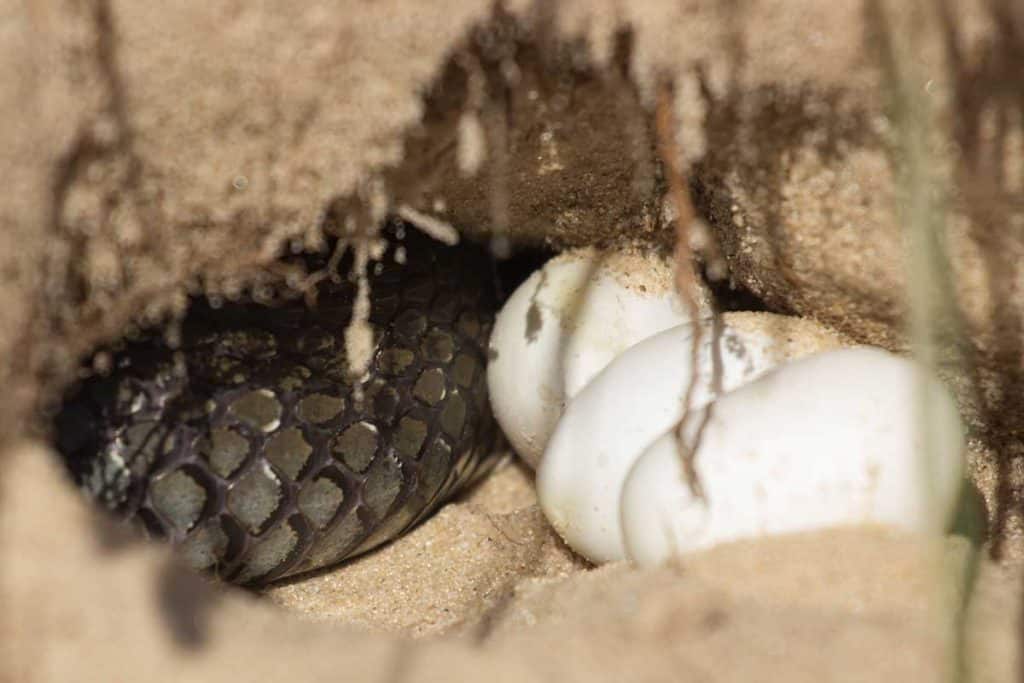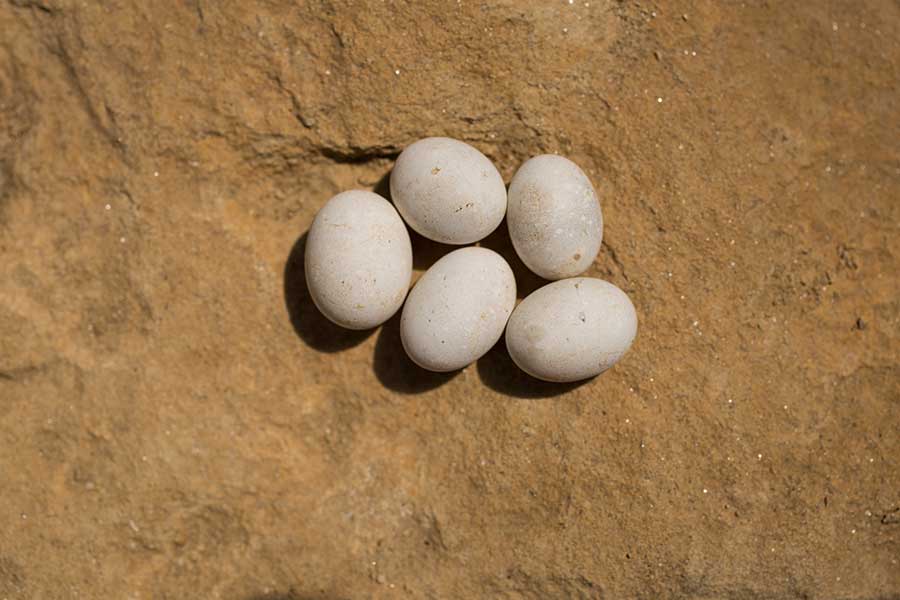Let’s compare snake eggs vs lizard eggs.
Are you a reptile enthusiast who wants to breed them? Perhaps you’re wondering if you can eat them. You might just be curious and want to know how to tell them apart!
Whatever your reasons are, we’re here to help and explain to you all of the important facts about snake and lizard eggs.
Both of these are reptile eggs, so they are very similar in many ways. However, there are some key differences to note. We’ll go over the key characteristics that set them apart in this article.
Read on to learn more about the main differences between snake eggs and lizard eggs and everything you need to know about each!
Main Differences Between Snake Eggs vs Lizard Eggs
The main differences to note between snake eggs vs lizard eggs are:
- Snake eggs are usually between one and five inches long, whereas lizard eggs are much smaller at around one to three centimeters.
- Snake eggs are easy to care for, whereas lizard eggs require more specific nesting conditions in order to hatch successfully.
- Snake eggs are edible for humans and packed with protein when cooked properly, whereas lizard eggs aren’t as practical to cook or eat.
Snake and lizard eggs are both reptile eggs, so they share a lot of similarities. However, they have some key differences, such as appearance and even edibility!
Snake Eggs vs Lizard Eggs: Overview
Although snake and lizard eggs might look similar at a glance to the uninformed, they have several key differences. Here’s a brief overview of each.
Snake Eggs
In the wild, snakes lay their eggs in a variety of places, and they usually lay them in a cluster. This helps the eggs retain moisture, which is necessary for their ability to hatch.
Snake eggs usually take between 45 and 70 days to hatch and require an incubation temperature that’s roughly 80 degrees Fahrenheit, though this can vary slightly from species to species.
Lizard Eggs
Lizards typically lay their eggs in a moist nesting area, similar to snakes. However, they are much smaller than you might expect at first glance.
Lizard eggs can take anywhere from 40 to 60 days to hatch. If you are incubating them, you’ll want to make sure the temperature is around 80 degrees Fahrenheit. If you know the species, it can help to research their specific needs as far as temperature and humidity.
Appearance and Size
As a reptile enthusiast, you’ve probably been curious about the size and appearance of different reptile eggs. So, how big are snake and lizard eggs, and what do they look like?
Snake Eggs
Depending on the species, snake eggs can be similar in size to chicken eggs. However, they do not have a hard shell like chicken or other bird eggs do.
Instead, they have a soft shell that feels almost like leather to the touch. They also aren’t as round as other eggs. They are typically long and oval-shaped.
In the wild, snake eggs are usually found in a clump together. This allows them to retain moisture more easily, which helps the babies hatch.
Lizard Eggs
Lizard eggs are oblong in shape like snake eggs and have the same leathery texture, which allows them to absorb water and stay moist.
However, a lizard’s eggs are usually much smaller than a snake’s. To put their size into perspective, snake eggs are usually between one and five inches, while lizard eggs are usually only one to three centimeters!
Caring for Reptile Eggs
If you are considering breeding either snakes or lizards, maybe you are wondering about how to care for their eggs. First things first: you’ll need a reptile incubator. But what do you do after that? Here’s a quick rundown on caring for both snake and lizard eggs.
Snake Eggs
Caring for snake eggs is relatively simple. You’ll need an egg box to place the eggs in with some kind of moisture-retaining substrate at the bottom. The purpose of this substrate is to keep the humidity up and the eggs moist.
Make sure there is ample ventilation, and whatever you do, don’t turn the eggs! While some eggs need to be rotated, like chicken eggs, for example, doing so can actually harm snake eggs as they are quite fragile.
Lizard Eggs
To care for lizard eggs, you should fill a small box with substrate and place it inside an incubator. You want to create a nest for them that’s similar to where the eggs would normally be placed in the wild.
The type of substrate you choose will depend on the species of lizard and what is most appropriate for it. Along with the heat from the incubator, you will also want to be sure to provide moisture and ventilation.
Closely monitor temperature and humidity for the highest chance of hatching lizard eggs successfully.
Which Is Easier to Care for?
Both snake eggs and lizard eggs are relatively easy to care for and hatch, but keep in mind that lizard eggs require you to put in a bit more effort to recreate their natural nesting conditions.
Eating Reptile Eggs
We eat chicken and sometimes even bird eggs, but what about reptile eggs? You might be wondering if they are safe to eat, and if so, how are they cooked? Additionally, what is their nutritional value? The short answer is yes, you can eat reptile eggs – but it’s not really recommended.
Snake Eggs
Snake eggs can be consumed if they are properly cooked. A rule of thumb is to prepare them similarly to how bird eggs are cooked.
Depending on the species, eating snake eggs can actually be beneficial, too. They are packed with protein and considered a nutritious delicacy in some countries!
Just avoid eating eggs of venomous snakes. While there is some debate within the reptile hobbyist community on how harmful this practice is, it’s better to be safe than sorry!
Lizard Eggs
While lizard eggs are smaller in size, they are still edible, though it may not be worth the effort to cook them.
Another thing to consider is that their leathery shell can make them difficult to crack open. They’re just not as practical to eat as snake eggs are.
Eating lizard eggs is a much less common practice, and for that reason, it’s not really something we would recommend.
Which Is More Edible?
While it’s not really common practice, you technically can eat reptile eggs. Of the two, snake eggs are probably the more edible option.
FAQs on Snake or Lizard Eggs
What do you do if you find snake eggs?
If you stumble across snake eggs outside, the best thing you can do is leave them be. Don’t move them around or mess with them. Try to keep a safe distance, because there could be adult — and possibly venomous — snakes nearby.
If the snake eggs are on your property, such as in your yard, don’t attempt to remove them on your own. Instead, call an expert to help you with removal. Another option is to contact a wildlife center that will be able to take in the eggs, identify them, and care for them until they hatch.
Are lizards hatched from eggs?
Most lizards reproduce by laying eggs. The number of eggs in a clutch varies widely depending on the lizard species, but somewhere between 4 and 20 per clutch is a pretty common number.
While most lizards are egg layers, some are viviparous, meaning they give live birth to their young. Yes, that’s right! These births are similar to that of mammals.
Interestingly, neither egg-laying nor viviparous lizards devote much care to their offspring. After they are born, the mother lizard usually leaves the babies to fend for themselves. Since baby lizards are able to eat an adult diet straight away, they do not need to feed on milk and will simply instinctively bury themselves in the ground to defend against predators.
Do snakes stay with their eggs?
Snakes, like lizards, typically don’t stay with their eggs after birth. This is because baby snakes are born with the ability to defend themselves and become fully independent very quickly.
The mother may stay close in a nearby area, but this is more out of convenience for her than a need to care for her offspring. She is not likely to provide any sort of protection to them, and she certainly won’t care for them as mammals care for their young.
Egg Identification Unlocked
When it comes to reptile eggs, many of them have very similar characteristics that can be difficult to differentiate.
This is especially true for snake eggs and lizard eggs. While they both have a similar appearance, snake eggs tend to be larger. They also have specific incubation requirements if you are trying to care for eggs until they hatch.
Whether you are considering breeding them, want to try cooking and eating them, or are just curious about their visual differences, you should now know everything you need to know about these eggs and what makes them unique!
Overall, neither is necessarily “better” than the other, but snake eggs are larger, more edible, and easier to incubate, while lizard eggs are smaller, less edible, and slightly more difficult to incubate successfully.




